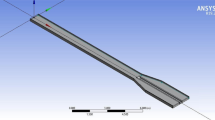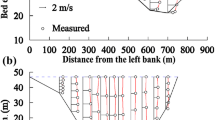Abstract
The rapid changes in flow pattern due to varying channel widths will make significantly impact on the hydraulic structures and evolutions of open channel. To better understand the impact of varying width, a flume experiment with adjustable width and a depth-averaged two-dimension numerical model were used to analyze the variations of flow parameters. Our experimental results showed that flow velocity gradually increased with decreasing water depth in converging region, and decreased with increasing water depth in diverging zones. It was also found that the turbulence intensity laws in three directions were not agreed with the theoretical relationships proposed by Nezu and Nakagawa in 1993 in straight open channel flows. The flow in the channel with varying width may change from the supercritical flow to the subcritical flow as a function of Froude number. Our numerical simulations with different flow rates showed that most of the hydraulic jumps in diverging region were submerged jump and the degree of submergence increased with increasing flow rate in gradual channel transition. When the flow rate increased, the range of supercritical flow rapidly decreased and the flow changed from the supercritical condition to the subcritical condition in diverging sections.
Similar content being viewed by others
References
Afzalimehr H, Anctil FO (2000) Accelerating shear velocity in gravel-bed channels. Hydrological Sciences-Journal-des Sciences. Hydrologiques 45 (1): 113–124. DOI: 10.1080/026 26660009492309
Armellini A, Casarsal L, Giannattasio P (2009) Separated flow structures around a cylindrical obstacle in a narrow channel. Experimental Thermal and Fluid. Science 33(4): 604–619. DOI: 10.1016/j.expthermflusci.2008.12.005
Barbhuiya AK, Talukdar S (2010) Scour and three dimensional turbulent flow fields measured by ADV at a 90° horizontal forced bend in a rectangular channel. Flow Measurement and. Instrumentation 21: 312–321. DOI: 10.1016/j.flowmeasinst. 2010.04.002
Blanckaert K, Vriend de HJ (2005) Turbulence characteristics in sharp open-channel bends. Physics of. Fluids 17 (5): 055102. DOI: 10.1063/1886726
Graber SD (2006) Asymmetric flow in symmetric supercritical expansions. Journal of Hydraulic Engineering ASCE 132(2):207–213. DOI: 10.1061/(ASCE)0733-9429(2006)132:2(207)
Hoan NT, Booij R, Stive MJF, et al. (2007) Deceleration openchannel flow in gradual expansion. The Fourth International Conference on Asian and Pacific Coasts (APAC), Nanjing, China. China Ocean Press. pp 902-915.
Leutheusser HJ, Fan JJ (2001) Backward flow velocities of submerged hydraulic jumps. Journal of Hydraulic Engineering. ASCE 127(6): 514–517. DOI: 10.1061/(ASCE)0733-9429(2001)127:6(514)
Lin C, Hsieh SC, Lin IJ, et al. (2012) Flow property and selfsimilarity in steady hydraulic jumps. Experiments in. Fluids 53: 1591–1616. DOI: 10.1007/s00348-012-1377-2
Liu MN, Rajaratnam N, Zhu DZ (2004) Turbulence structure of hydraulic jumps of low Froude numbers. Journal of Hydraulic Engineering ASCE 130(6):511–520. DOI: 10.1061/(ASCE)0733-9429(2004)130:6(511)
Lucy C, Quine TA and Nicholas A (2010) An experimental investigation of autogenic behavior during alluvial fan evolution. Geomorphology 115(3/4): 278–285. DOI: 10.1016/j.geomorph.2009.06.033
Misra SK, Kirby JT, Brocchini M, et al. (2008) The mean and turbulent flow structure of a weak hydraulic jump. Physics of. Fluids 20: 035106. DOI: 10.1063/1.2856269.
Molls T, Chaudhry MH (1995) Depth-averaged open-channel flow model. Journal of Hydraulic. Engineering 121(6): 453–465.
Nezu I, Nakagawa H (1993) Turbulence in open-channel flows. IAHR, Rotterdam, Netherlands: A.A.Balkema Publishers. pp 53–54.
Paiement-Paradis G, Marquis G, Roy A (2011) Effects of turbulence on the transport of individual particles as bedload in a gravel-bed river. Earth surface processes and. landforms 36(1): 107–116. DOI: 10.1002/esp.2027
Papanicolaou AN, Hilldale R (2002) Turbulence characteristics in gradual channel transition. Journal of Engineering. Mechanics 128: 948–960. DOI: 10.1061/(ASCE)0733-9399(2002)128:9(948)
Singha A, Balachandar R (2011) Structure of wake of a sharpedged bluff body in a shallow channel flow. Journal of Fluids and. Structures 27(2): 233–249. DOI: 10.1016/j.jfluidstructs. 2010.11.001
Thompson JF, Warsi ZUA, Mastin CW (1985) Numerical grid generation: foundations and applications. Elsevier North-Holland, Inc. New York, NY, USA. pp 141–142.
Wang XY, Yang QY, Lu WZ, et al. (2011) Experimental study of near-wall turbulent characteristics in an open-channel with gravel bed using an acoustic Doppler velocimeter. Experiment in. Fluids 52: 85–94. DOI: 10.1007/s00348-011-1202-3
Weber LJ, Eric DS, Nicola M (2001) Experiments on flow at a 90° open-channel junction. Journal of Hydraulic Engineering. ASCE 127(5): 340–350. DOI: 10.1061/(ASCE)0733-9429(2001)127:5(340)
Wu S and Rajaratnam N (1996) Transition from hydraulic jump to open channel flow. Journal of Hydraulic Engineering. ASCE 122(9): 526–528. DOI: 10.1061/(ASCE)0733-9429(1996)122:9(526)
Wu CG (2008) Hydraulics. Higher Education Press, Beijing, China. pp 285–287. (In Chinese)
Yan XF, Yi ZJ, Liu TH, et al. (2011) Flow structure and characteristics of local head loss in transition channel. Journal of Yangtze River Scientific Research. Institute 28(9): 1–5. (In Chinese)
Yang QY, Lu WZ, Zhou SF, et al. (2014) Impact of dissipation and dispersion terms on simulations of open-channel confluence flow using two-dimensional depth-averaged model. Hydrological. Processes 28: 3230–3240. DOI: 10.1002/hyp. 9881
Yang QY, Wang XY, Lu WZ, et al. (2009) Experimental study on characteristics of separation zone in confluence zones in rivers. Journal of Hydrologic Engineering. ASCE 14(2): 166–171. DOI: 10.1061/(ASCE)1084-0699(2009)14:2(166).
Author information
Authors and Affiliations
Corresponding author
Additional information
http://orcid.org/0000-0003-0065-404X
http://orcid.org/0000-0002-4744-5002
http://orcid.org/0000-0002-8996-7618
http://orcid.org/0000-0002-9095-1306
Rights and permissions
About this article
Cite this article
Wang, Xk., Wang, Bj., Liu, Xn. et al. Effects of river width changes on flow characteristics based on flume experiment. J. Mt. Sci. 13, 361–368 (2016). https://doi.org/10.1007/s11629-014-3265-0
Received:
Revised:
Accepted:
Published:
Issue Date:
DOI: https://doi.org/10.1007/s11629-014-3265-0




